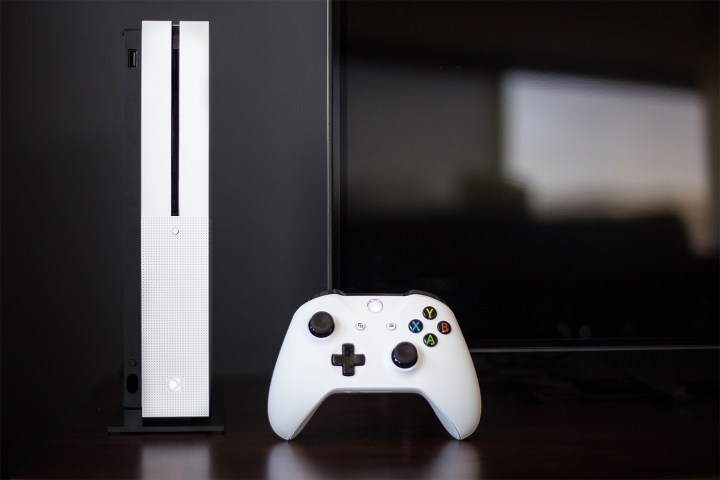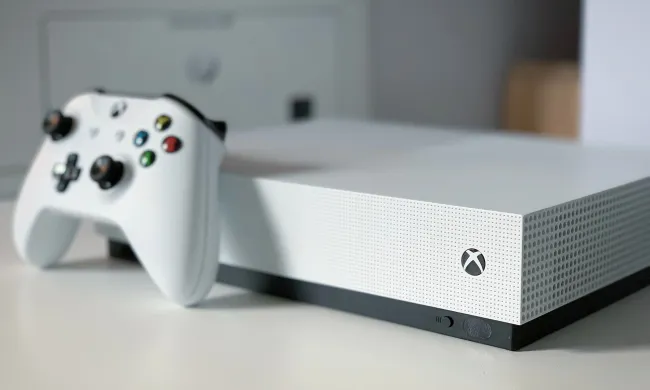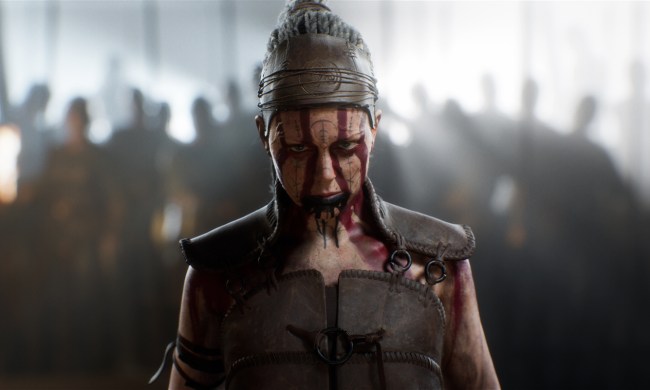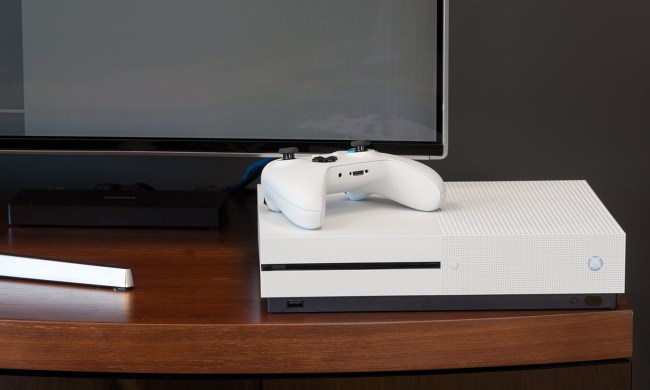“The Xbox One S is more than a console – it’s a great Ultra HD Blu-Ray player.”
- Slick new look
- Strong input/output selection
- Ultra HD Blu-ray support
- Enhanced compatibility with Windows 10
- Attractive pricing
- Not as small as expected
- Hardware still slower than PlayStation 4
- Cortana is disappointing
Xbox One S is Microsoft’s cheaper mid-cycle refresh of the Xbox One, representing both 4K media support and a better name for Xbox. On the hardware side, its miniaturization is meant to leapfrog the PlayStation 4, which still smaller and subtler than the original Xbox One. On the software side, the Xbox One S is Microsoft’s standard-bearer for Windows 10. While older Xbox One consoles can update to the same software, there’s still a lot of confusion about how Windows 10 and Xbox work together. The updated console is positioned to provide clarity.
A heavy burden rests on the shoulders of this console, one too heavy for an incremental upgrade. Sony has not only launched a “slim” PlayStation 4, but a substantially upgraded version of its console, the PlayStation 4 Pro. Microsoft also has its own high-powered Xbox One X, which happens to be the most powerful console right now, but Xbox One S is the much cheaper alternative.
Despite its low price point, with exciting new features like Game Pass that complement Microsoft’s vision for the Xbox One, the One S doesn’t have the improvements one would expect from a console upgrade, nor is it the start of a new generation.
Smaller, but not that small
We liked the look of the original Xbox One and thought it held up better visually than the PlayStation 4, which, with its awkward angles, never looks quite right. But, in practical terms, the Xbox One had a big problem. It was big – the biggest thing most people put in a home entertainment cabinet aside from an A/V receiver.
Microsoft fixed that by shrinking the Xbox One S by 40 percent. Sounds great, right? Yet, the number is deceiving. The box is just a few inches narrower and about an inch shorter than the original. The power supply is now internal, as well.
The less-than-expected miniaturization means the new Xbox only just catches up with the svelte PlayStation 4. The Xbox One S is wider and a hair taller, but not quite as deep.
While the new Xbox isn’t as small as the numbers make it seem, it is indisputably attractive. It’s minimalist, uniform, and simple, with clean, sharp lines. The two-face design of the original makes a return here – half the Xbox One S is flat, while the other half is dotted with exhaust vents.
Unlike the original, the vented half uses a grid of dimples rather than diagonal slats. This is reminiscent of pixels and feels right at home on a game console. A large cut-out for the top-facing fan slightly spoils the look when viewed from above but, due to its position, it’s hard to notice when placed in an A/V cabinet. Most people will only consider the Xbox One S from the front, and from that angle, it’s easily the best-looking console released this generation.
Fun and functional
The original Xbox One could be a pain to interact with because of its touch-sensitive power button. Other buttons, like the controller sync button, were physical but inconveniently located.
While the new Xbox isn’t as small as the numbers make it seem, it is indisputably attractive.
Happily, the Xbox One S solves these problems. The front includes a physical power button, controller sync button, and disc eject button. All are easy to find and use, even in a dim media room. There’s also one USB 3.0 port upfront – a bit disappointing. However, the PlayStation 4 has two. Finally, the lower right corner hides the IR blaster, which can be used to control other IR devices through your Xbox One S by repeating the IR signal those devices recognize.
Around back the Xbox One S includes two HDMI ports (one in, one out), two more USB 3.0 ports (one for Kinect), S/PDIF, and Ethernet.
Overall, the connectivity is almost identical to the original, with one notable exception. The Xbox One S drops the dedicated Kinect port. You’ll need a USB adapter to plug a previous Kinect into the new console. Aside from the annoyance of having to obtain an adapter (Microsoft is handing them out for free, at least, if you contact Xbox support), this change means Kinect users effectively have one less USB port than they did previously.
Still, the Xbox One offers more connectivity than the PlayStation 4. Microsoft has pitched Xbox One as a one-stop solution for everything from gaming to television. While it’s debatable whether its features have caught on with the mainstream, they remain something the PlayStation 4 doesn’t even try to emulate.
Once again, a console under-cuts Blu-ray players
While previous Xbox One consoles were limited to 1080p video output across both games and video, the Xbox One S adds support for 4K video, as well as a 4K Blu-ray player that isn’t found in either the PlayStation 4 or the PlayStation 4 Pro.
To be clear, the support for 4K resolution does not have an impact on games. They will render with the same frame buffer as before. But unlike the original system, the Xbox One S is capable of native 4K output for the interface, as well as media. You can play 4K, HDR Blu-rays on that fancy new UltraHD television you purchased, or you can load up Netflix for 4K streaming.
HDR, short for “high-dynamic range,” on the other hand, does work and will provide a boost in image quality if your television supports HDR. That said, HDR mixes strangely with this console’s 1080p target because TVS with HDR also usually boast 4K resolution. In that case, the Xbox One X would make more sense.
Support for 4K is largely unnoticed once you turn it on – and that’s a good thing. You can set the Xbox One S to 4K output and leave it there without worrying about your source content. 4K movies look just as detailed as you would expect, but games – which, again, still render at whatever resolution they were originally designed for – look as good as they would on a 1080p display. Even Hyper Light Drifter’s pixel-art style looked razor-sharp.
That will make the Xbox One incredibly attractive to anyone who has a 4K display. Stand-alone Ultra HD Blu-ray players remain few, and those available are expensive. Ultra 4K Blu-ray players can run for $200-$249 on sale for the most affordable models. That suddenly makes the Xbox One S, which regularly goes for $200, an economical purchase.
Strangely, a full-fledged console has managed to undercut dedicated home media players, but this has happened before. Some gamers may remember that the PlayStation 3, the first console to include a Blu-ray player, undercut most dedicated players at the time it released. The Xbox One S pulls the same trick, and for that reason alone, it should grab the attention of every home theater enthusiast.
It’s still an Xbox One
The Xbox One S is a new design, but it’s not an entirely new console. Aside from what’s above, everything else about it remains the same.
That’s a problem. The Xbox One has sold poorly, relative to the PlayStation 4, for a simple reason. Most games will play on either console, but Sony’s is more powerful, and games look a bit better on it. Sony also has some top-notch exclusives that the Xbox will never see.
The Xbox One S doesn’t do anything to resolve that. It is slightly quicker due to higher clock speeds on the GPU and associated ESRAM. That’s enough to net an extra couple of frames in titles that run at an unlocked framerate, and it can smooth out tearing in some games, but the difference is usually not noticeable in gameplay. We only know about it all thanks to Eurogamer’s Digital Foundry, one of a small handful of publications equipped to do a frame-by-frame analysis of a console. Microsoft said nothing about improved in-game performance in its official press guide to the Xbox One S.
Microsoft lost this generation of the so-called “console wars.” The Xbox One S did nothing to change that fact.
Our Take
Most gamers are unlikely to find the Xbox One S more appealing than it was before. It remains less powerful than its rival at Sony. Aside from its smaller footprint – which, as mentioned, is less impressive than hinted during its reveal – there’s nothing about the Xbox One S that will get an enthusiast’s attention.
That said, while Xbox One S isn’t the best gaming console available today, it is a great home theater appliance. The Xbox One S has a 4K capable Blu-ray player — a feature unavailable on the PS4 or PS4 Pro — that alone may be worth the price of entry, provided you have a 4K television.
Is there a better alternative?
The Xbox One S achieves parity with the standard PlayStation 4 in almost every way, though, that console’s ubiquity among gamers may lead to the PlayStation 4 versions of multiplatform games receiving more attention from their developers.
How long will it last?
It depends on how often you like to upgrade your console. Microsoft’s more powerful version of the Xbox One, the “Xbox One X,” is already out now for reasonably low prices as well. And the next generation is still set to arrive this year with the release of the Xbox Series X. While most games like Halo Infinite will remain compatible with the Xbox One S for at least a year, time is ticking on this generation.
Should you buy it?
No. The Xbox One S is an aging console that won’t make sense for most gamers with a new generation on the way.
This article was last updated by Digital Trends contributor Cody Perez on April 27, 2020.










